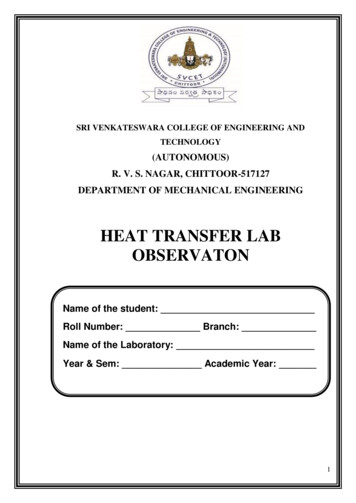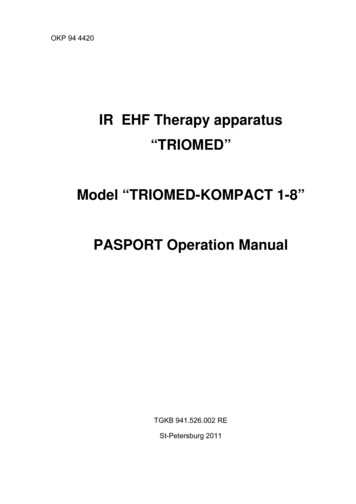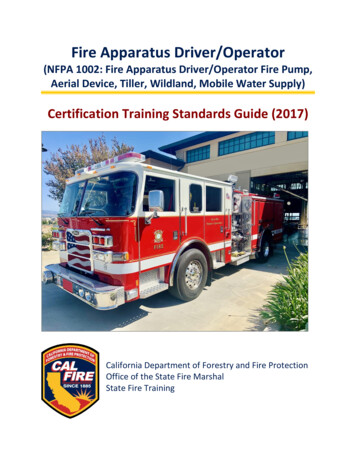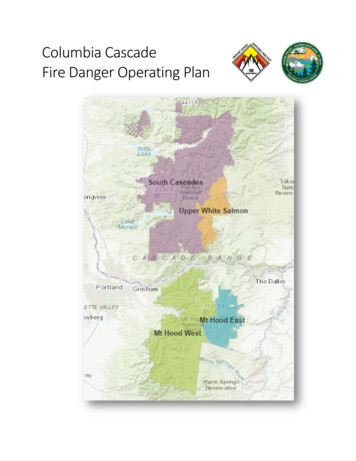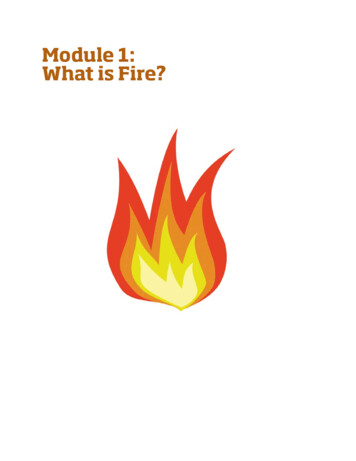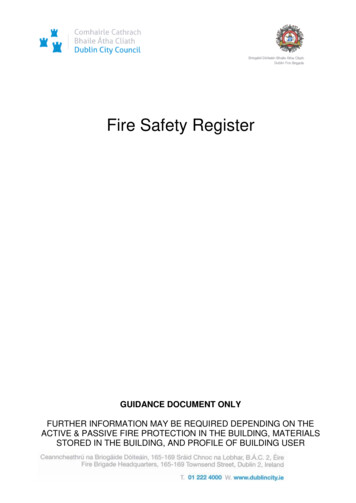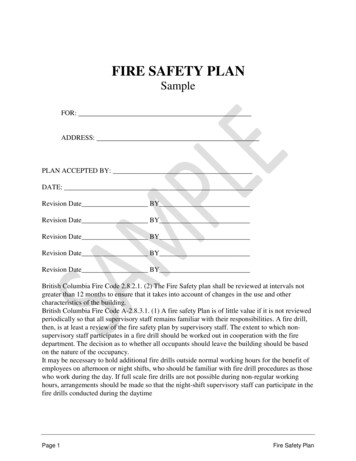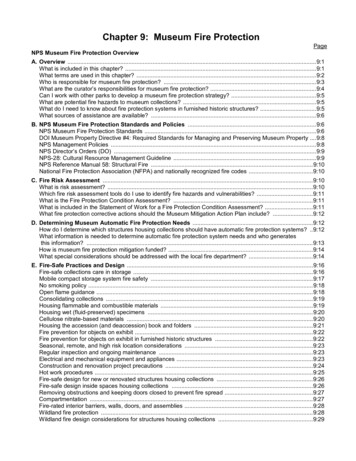
Transcription
Fire ApparatusReplacemen t Plan2018-2032
AbstractTo maximize fire fighter capabilities in using fire apparatus and minimize risk of injuries, it isimportant that fire apparatus be equipped with the latest safety features and operating capabilities.In the last 10 to 15 years, much progress has been made in upgrading functional capabilities andimproving the safety features of fire apparatus. Apparatus manufactured prior to 1991 usuallyincluded only a few safety upgrades required by the 1991 edition of the NFPA fire departmentapparatus standards and other fire apparatus standards. Because the changes, upgrades, andfine tuning to NFPA 1901, Standard for Automotive Fire Apparatus, since 1991 have been trulysignificant, especially in the area of safety, fire departments should seriously consider the value (orrisk) to fire fighters of keeping pre-1991 fire apparatus in first-line service.A scheduled apparatus replacement plan improves the process of vehicle replacement andallows for planning of funding sources. The framework for this plan is based on a previousreplacement plan submitted in 2014. It has been updated to reflect the current needs of eachdepartment and expanded to 15 years to show a replacement pattern for most vehicles in thefleet. The goal of this plan is to ensure that heavy fire apparatus are replaced when necessaryto maintain a safe, reliable, and innovative fleet and do so in a cost-efficient manner. The plandoes not include replacing Brush Trucks and other Support Vehicles. The departments havedecided that they will replace these trucks in-house on an as-needed basis.It is a generally accepted fact that fire apparatus, like all types of mechanical devices, have afinite life. The length of that life depends on many factors, including vehicle mileage and enginehours, quality of the preventative maintenance program, quality of the driver training program,whether the fire apparatus was used within the design parameters, whether the apparatus wasmanufactured on a custom or commercial chassis, quality of workmanship by the originalmanufacturer, quality of the components used, and availability of replacement parts, to name afew. In the fire service, there are fire apparatus with 8 to 10 years of service that are simply wornout. There are also fire apparatus that were manufactured with quality components, that have hadexcellent maintenance, and that have responded to a minimum number of incidents that are still inserviceable condition after 20 years. Factors influencing apparatus replacement are age,mileage, cost per mile, and overall condition of the vehicle. The greatest weight in this plan isplaced on age and mileage.Carroll County has three primary fire departments that cover the majority of our county. Thereplacement of apparatus throughout the years has been a combination of the individualdepartments purchasing, or at various periods, the departments have requested the Board ofSupervisors to purchase needed apparatus .The care and maintenance of the trucks has been the responsibility of the individual departments;therefore, this effort has had varying degrees of success due to tight budgets leaving little funds tomaintain apparatus through an organized maintenance program. The county should for futurestability, consider contracts with trained qualified fire apparatus technicians to insure the propermaintenance and longevity of the fleet is properly maintained.The next few pages of this document will provide a few definitions for how fire apparatus fit in toan operation and a quick overview of the fire stations and the recommended placement of theapparatus . The document includes a replacement plan schedule for the next 15 years; however,the first five (5) years of a replacement plan is the realistic view for replacement and is the mostcritical for consideration. Each department fleet is broken down with factors to include the year,type, manufacturer, life expectancy, age, purpose and other factors that are to be consideredwhen recommendations are made for replacement.
DefinitionsFire Apparatus: Term used to describe vehicles of varying types and sizes that fulfil differentroles or functions during fire and rescue operations.Class A Pumper: This term is used to describe an apparatus meeting that criterion for apumper truck that can be used to fight fires in structures or other types of fires requiring largervolumes of water.Tanker Truck: This term is used to describe an apparatus that supplies water to other trucks ordrop tanks during fire operations. If provided with a pump, this type of truck usually does nothave high volume pumps.Tanker/Pumper: This term is used to describe an apparatus that supplies water to other trucksor drop tanks during fire operations . However, the pumps are usually large enough that the truckcould be used to fight fires just as you would be able to with a Class A Pumper. These truckscould have access issues do to the weight of the truck where a Class A Pumper would workbetter. It is recommended this type of truck be purchased versus just a standard Tanker due toits versatility and ability to support other pumpers with water supply.Fire/Rescue Class A Pumper:This term is used to describe a specially designed fireapparatus that is used for multi-operations including fire suppression, vehicle extrications andother light rescue operations . It reduces the need to have multiple trucks responding on certaincalls reducing cost ultimately for a department.Brush Truck: This term is used to describe usually a smaller fire vehicle that is used for woodsand brush fires. They are much lighter than larger apparatus and can access areas much easierthan larger apparatus. They carry smaller high pressure pumps and less water, but are a veryeffective tool, especially in this area due to the terrain encountered during fires.Crash/Rescue: This term is used to describe different styles of trucks used in various rescueoperations. These operations can include vehicle accident extrication, building collapse,confined space rescues and other specialized rescue operations.Utility/Support Units: This term is used to describe different styles of trucks used in variousways to assist prior to, during, and after emergencies. They may carry equipment, supplies andpersonnel for emergency operations. They also are used to pull trailers and other devices.Support Unit: This term is used to describe various styles of vehicles used to provide supportduring an emergency. The vehicles can range from automobiles, trucks to tractors. Most of theuses for this plan are for providing transportation for personnel to emergencies, training andmutual aid.GPM: This term is used for describing the amount of water flow volume capability of a particularpump installed on an apparatus.NFPA: The National Fire Protection Association (NFPA) is a non-profit organization that utilizesits membership to develop standards for fire and life safety. The document includes standardsfor the construction and safety features used on fire apparatus and other equipment used by thefire service. NFPA also covers thousands of other standards that relate to fire and life safety.These standards are generally the nationally accepted standards and processes and can belegally binding in certain situations.
ISO: The Insurance Service Office/Commercial Risk Services is an organization that generallyrates communities on their ability to provide a level of fire protection. The rating for manyresidential properties can affect the amount of insurance paid by a home owner in a coveragearea. For the purposes of this document, this process only considered that we maintain thecurrent ISO ratings in each fire response area. However, older apparatus that fall within thereplacement recommendation of NFPA may receive deficiency points for future ISO ratings ifnot replaced.Department OverviewThe Fire Departments have been very helpful in obtaining the information needed for thisreplacement plan. Apparatus review surveys were prepared for each vehicle in the departmentsfleets. These surveys considered many factors that affect the effective operation of a fleet of fireapparatus. The survey is based upon nationally excepted practices. A copy of this survey reviewsheet is included in this document showing the criteria used to assist in determining therecommendations for this plan.Laurel Fork Volunteer Fire Department (LFVFD)LFVFD operates from two (2) stations both located off of Highway 58. The department currentlyhas a Tanker that has been out of service. They do not have a back-up when one of the twopumpers is out of service. A Tanker/Pumper (high priority) needs to be purchased to support withenough water for the simplest structure fire and for back up when an Engine is being repaired.You will note that this is the first truck to be replaced according to the plan. The department has accepted abid from a manufacturer and we plan take delivery early in 2018. The department has just enoughapparatus, if a desire to improve the ISO rating in the future, then other improvements will beneed. The department will need to maintain the following apparatus:Station # 1: 1 -Class A Pumper, 1 - Tanker/Pumper, 1- Brush Truck, 1 - Crash/Rescue,1 - Support vehicle.Station #2: 1 - Class A Pumper , 1 - Brush Truck
Hillsville Volunteer Fire Department (HVFD)HVFD operates from three (3) stations with on located on Fulcher Street (Station #1), one located nearthe airport (Station #2), one located on Double Cabin Road in Dugspur (Station #3). This fleet appears tobe the newer of the fleets in Carroll County. However, there are trucks that exceed the recommendedstandards for age of vehicles. It is recommended a Fire/Rescue Class-A Pumper be purchased for thedepartment to replace one of the current pumpers that has high maintenance cost and has reached themaximum recommended age. This truck is designed to be used to transport extrication equipment andother equipment that can be used during vehicle accidents and has multiple uses especially in use on I-77.The Fire/Rescue Class A Pumper will eliminate the need for a Crash Truck and this unit can be repurposed as a Haz-Mat truck which is something that is needed and can be used county-wide. This planwill allow the HVFD to maintain is current ISO rating as it relates to fire apparatus. The departmentneeds to maintain the following apparatus:Station #1: 1 - Class A Pumper, 1- Fire/Rescue Class A Pumper, 1 -Tanker/Pumper,1- Brush Truck, 1 - Haz-Mat Truck, 1 - Utility/support, 1 - Support vehicleStation #2: 1 - Class A Pumper, 1- Tanker/Pumper, 1- Brush Truck, 1 - Utility/SupportStation #3; 1 - Class A Pumper, 1 - Brush TruckCana Volunteer Fire Department (CVFD)CVFD operates from four (4) stations with one located near Highway 52 south (Station #1), nearFlower Gap and Pipers Gap Road (Station #2), near Wards Gap Road and Mt. Bethel Rd (Station#3), and within the Cascades neighborhood off of the Parkway (Station #4). The fleet has anumber of older apparatus in the fleet that will need to be replaced. There are two, Class-AEngines that cannot pass pump test and due to age, these need to be replaced. However, itshould be noted, this plan is recommending that we eliminate one (1) of these Engines, replacingboth Engines with a Fire/Rescue Class-A Pumper. This type of truck is designed to be used totransport extrication equipment and other equipment that can be used during vehicle accidentsand has multiple uses especially in use on I-77. To maintain its 6/9 ISO rating, the department willneed to maintain following apparatus:Station #1: 1 - Class A Pumper, 1 - Fire/Rescue Class A Pumper, 1 - Tanker/Pumper,1 - Brush Truck, various support and utility vehicles.Station #2: 1 - Class A Pumper, 1 - Brush TruckStation #3: 1 - Class A Pumper, 1 - Tanker/Pumper, 1 - Brush TruckStation #4: 1 - Class A Pumper
Laurel Fork Volunteer Fire DepartmentUnitEngine 1Engine 2Tanker 3Brush 4Support 5Support 6Crash 7Brush rnationalModel4400 4x24400 SBA 4x24400 SBA 4x2F‐350 4x4E series 4x4Suburban 15005500 4x4Loadstar ass A EngineClass A EnginePumper/TankerBrush TruckCrash TruckSupportSquad/FoamBrush TruckPump Size12501250250Unkn/an/aUnk250Tank airExcellentPoor
Hillsville Volunteer Fire roletQuintModel5500 00 4TypeMini‐PumperClass A EngineTanker/PumperBrush TruckClass A EngineCrash TruckBrush TruckTanker/PumperClass A EngineSupportSupportSupportLadderPump nk ‐serviceConditionExcellentVery GoodExcellentVery GoodVery GoodVery GoodVery GoodExcellentFairFairExcellentVery GoodExcellent
Cana Volunteer Fire DepartmentUnitEngine 1Engine 2Engine 3Engine 4Engine 5Engine 6(old) Brush 7Brush 7Brush 8Brush 9Tanker 10Tanker 11Extrication 15Support 18Support 2010200020111997MakeAmerican 4728013602551411481912545138958TypeClass A EngineClass A EngineClass A EngineClass A EngineClass A EngineClass A EngineBrush TruckBrush TruckBrush TruckBrush TruckTankerPumper/TankerCrash TruckSupportSupportPump n/aTank PoorExcellentVery GoodExcellentExcellent
Capital Replacement of Fire Apparatus (Heavy plus Brush FVFD Tanker (Tanker 3)LFVFD Fire/Res Class A Pumper (Eng 1) (Crh 7)LFVFD Brush Truck (Brush 4)LFVFD Brush Truck (Brush 9) **LFVFD Class A Pumper (Eng 2)HVFD Fire/Rescue Class A Pumper (110) (107)**HVFD Mini‐Pumper 4x4 (100)HVFD Class A Pumper (101)HVFD Brush Truck (104)HVFD Class A Pumper (106)HVFD Tanker Pumper (109)HVFD Tanker Pumper (102)HVFD Brush Truck (108)CVFD Fire/Rescue Class A Pumper (E‐5) (E‐7)**CVFD Brush Truck (B‐7)CVFD Tanker Pumper (T ‐ 11)CVFD Tanker Pumper (T ‐ 10)CVFD Class A Pumper (E‐2)CVFD Brush Truck (B‐9)CVFD Class A Pumper (E‐3)CVFD Class A Pumper (E‐4)CVFD Class A Pumper 450,000100,000100,000450,000 450,000n/a450,000450,000350,000 300,000 450,000 650,000 450,000 450,000 450,000 450,000 100,000 350,000 350,000 450,000 6,475,000650,000650,000650,000375,000 7352725‐27This plan does not add any apparatus to fleet and reduces fleet by 3 vehicles.Plan includes all department apparatus except Support and Utility Vehicles.Departments will replace Support and Utility Vehicles in house as needed using their own funds.AVG/yr 431,667Vehicles above with no action would be replaced beyond this 15 year window.** LFVFD ‐ If Engine 2 and Crash 7 are replaced with one Rescue Pumper, then Crash 7 could be repurposed as a Brush Truck.** HVFD ‐ If 110 and 107 are replaced with one Rescue Pumper, then 107 could be repurposed as a Haz‐Mat Truck to be used by all departments.** CVFD ‐ Replacing E‐5 and E‐6 with one Rescue Pumper will reduce the number of pumpers by one. Extrication 15 will remain in service as a secondary crash truck for station 2.AVG age27
to maintain a safe, reliable, and innovative fleet and do so in a cost-efficient manner. The plan . quality of the preventative maintenance program, quality of the driver training program, whether the fire apparatus was used within the design parameters, whether the apparatus was . The Insurance Service Office/Commercial Risk Services is an .
